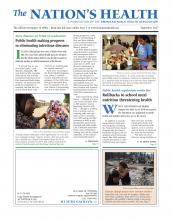The Midwest is seeing its highest number of Lyme disease-carrying ticks, according to new research.
In a study conducted at the University of Minnesota School of Public Health and published June 17 in the Journal of Medical Entomology, researchers found that the proportion of Lyme-disease carrying ticks in Iowa increased from 8 percent to 23.5 percent between 1998 and 2013. Infected ticks also spread from Iowa’s northeast corner to cover two-thirds of the state and expanded in neighboring states such as Minnesota, Illinois and Wisconsin, according to lead author Jonathan Oliver, PhD, public health entomologist and assistant professor in the Division of Environmental Health Sciences.
Lyme disease is caused by bacteria carried by the blacklegged tick, commonly called the deer tick, which is passed to humans through tick bites. It causes flu-like symptoms and skin rashes and, if left untreated, can result in long-term damage to joints, the heart and the nervous system, according to the Centers for Disease Control and Prevention. According to the study authors, deer ticks are the most important disease vectors affecting humans in the U.S.
The research team processed over 11,000 ticks mailed to an Iowa tick-borne disease surveillance program between 1990 and 2013. Their results showed that the proportion of deer ticks rapidly increased in that time, with the number of counties reporting deer ticks rising from nine to 72.
While the increase points to a greater abundance of deer ticks, the study noted that other factors, such as more awareness of tick-borne diseases and tick identification services, may have had an influence. More ticks carrying Lyme disease in wider areas, however, poses a serious health risk.
“Treatments for Lyme disease are effective, but diagnosing it is still really difficult,” Oliver said in a news release.
He recommended taking precautions such as wearing long pants in wooded areas, using insect repellents containing DEET and checking regularly for ticks. Knowing the symptoms of Lyme disease as well as other tick-borne diseases is also crucial, as is getting swift treatment, according to CDC.
Oliver and other experts said that growing populations of white-tailed deer may be behind the rapid spread of deer ticks in the Midwest. As the insect’s natural host, white-tailed deer are able to carry deer ticks to otherwise inaccessible areas as they roam between forest patches. The researchers also pointed to reforestation as a major factor, citing the expansion of forested areas in Iowa from 1.6 million acres in 1974 to almost 3 million acres in 2013.
Oliver said he believed that the threat of tick-borne diseases will only become more severe without increased federal funding for tick research.
For more information, visit: https://academic.oup.com/jme/article-abstract/doi/10.1093/jme/tjx121/3869823/Range-Expansion-and-Increasing-Borrelia?redirectedFrom=fulltext
- Copyright The Nation’s Health, American Public Health Association









